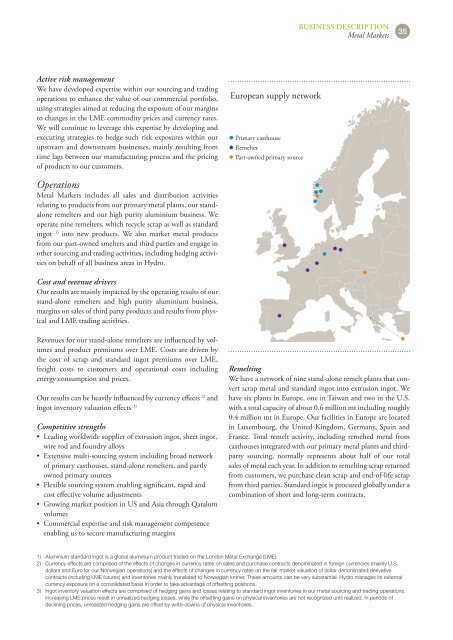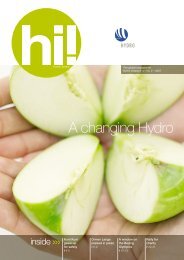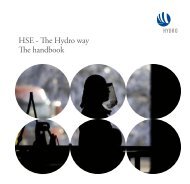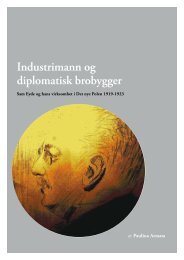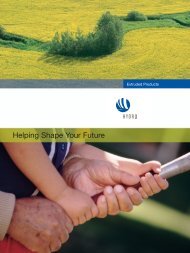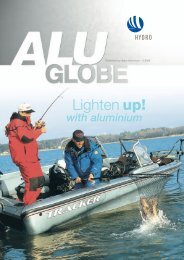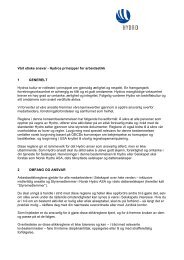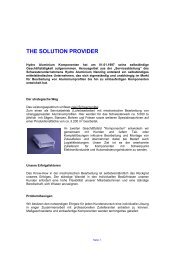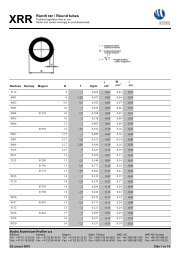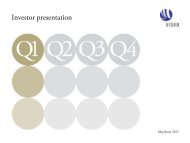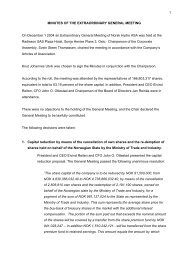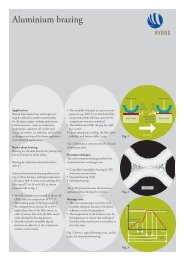Hydro Annual Report 2011b
Hydro Annual Report 2011b
Hydro Annual Report 2011b
Create successful ePaper yourself
Turn your PDF publications into a flip-book with our unique Google optimized e-Paper software.
Active risk management<br />
We have developed expertise within our sourcing and trading<br />
operations to enhance the value of our commercial portfolio,<br />
using strategies aimed at reducing the exposure of our margins<br />
to changes in the LME commodity prices and currency rates.<br />
We will continue to leverage this expertise by developing and<br />
executing strategies to hedge such risk exposures within our<br />
upstream and downstream businesses, mainly resulting from<br />
time lags between our manufacturing process and the pricing<br />
of products to our customers.<br />
Operations<br />
Metal Markets includes all sales and distribution activities<br />
relating to products from our primary metal plants, our standalone<br />
remelters and our high purity aluminium business. We<br />
operate nine remelters, which recycle scrap as well as standard<br />
ingot 1) into new products. We also market metal products<br />
from our part-owned smelters and third parties and engage in<br />
other sourcing and trading activities, including hedging activities<br />
on behalf of all business areas in <strong>Hydro</strong>.<br />
Cost and revenue drivers<br />
Our results are mainly impacted by the operating results of our<br />
stand-alone remelters and high purity aluminium business,<br />
margins on sales of third party products and results from physical<br />
and LME trading activities.<br />
Revenues for our stand-alone remelters are influenced by volumes<br />
and product premiums over LME. Costs are driven by<br />
the cost of scrap and standard ingot premiums over LME,<br />
freight costs to customers and operational costs including<br />
energy consumption and prices.<br />
Our results can be heavily influenced by currency effects 2) and<br />
ingot inventory valuation effects 3)<br />
Competitive strengths<br />
• Leading worldwide supplier of extrusion ingot, sheet ingot,<br />
wire rod and foundry alloys<br />
• Extensive multi-sourcing system including broad network<br />
of primary casthouses, stand-alone remelters, and partly<br />
owned primary sources<br />
• Flexible sourcing system enabling significant, rapid and<br />
cost effective volume adjustments<br />
• Growing market position in US and Asia through Qatalum<br />
volumes<br />
• Commercial expertise and risk management competence<br />
enabling us to secure manufacturing margins<br />
European supply network<br />
Primary casthouse<br />
Remelter<br />
Part-owned primary source<br />
BusIness DesCrIptIon<br />
Metal Markets<br />
35<br />
Remelting<br />
We have a network of nine stand-alone remelt plants that convert<br />
scrap metal and standard ingot into extrusion ingot. We<br />
have six plants in Europe, one in Taiwan and two in the U.S.<br />
with a total capacity of about 0.6 million mt including roughly<br />
0.4 million mt in Europe. Our facilities in Europe are located<br />
in Luxembourg, the United Kingdom, Germany, Spain and<br />
france. Total remelt activity, including remelted metal from<br />
casthouses integrated with our primary metal plants and thirdparty<br />
sourcing, normally represents about half of our total<br />
sales of metal each year. In addition to remelting scrap returned<br />
from customers, we purchase clean scrap and end-of-life scrap<br />
from third parties. Standard ingot is procured globally under a<br />
combination of short and long-term contracts.<br />
1) Aluminium standard ingot is a global aluminium product traded on the London Metal Exchange (LME).<br />
2) Currency effects are comprised of the effects of changes in currency rates on sales and purchase contracts denominated in foreign currencies (mainly U.S.<br />
dollars and Euro for our Norwegian operations) and the effects of changes in currency rates on the fair market valuation of dollar denominated derivative<br />
contracts (including LME futures) and inventories mainly translated to Norwegian kroner. These amounts can be very substantial. <strong>Hydro</strong> manages its external<br />
currency exposure on a consolidated basis in order to take advantage of offsetting positions.<br />
3) Ingot inventory valuation effects are comprised of hedging gains and losses relating to standard ingot inventories in our metal sourcing and trading operations.<br />
Increasing LME prices result in unrealized hedging losses, while the offsetting gains on physical inventories are not recognized until realized. In periods of<br />
declining prices, unrealized hedging gains are offset by write-downs of physical inventories.


